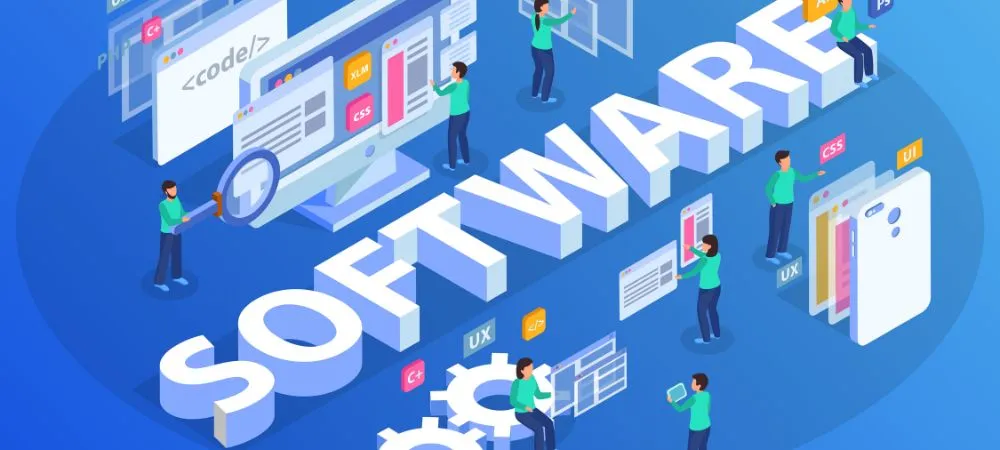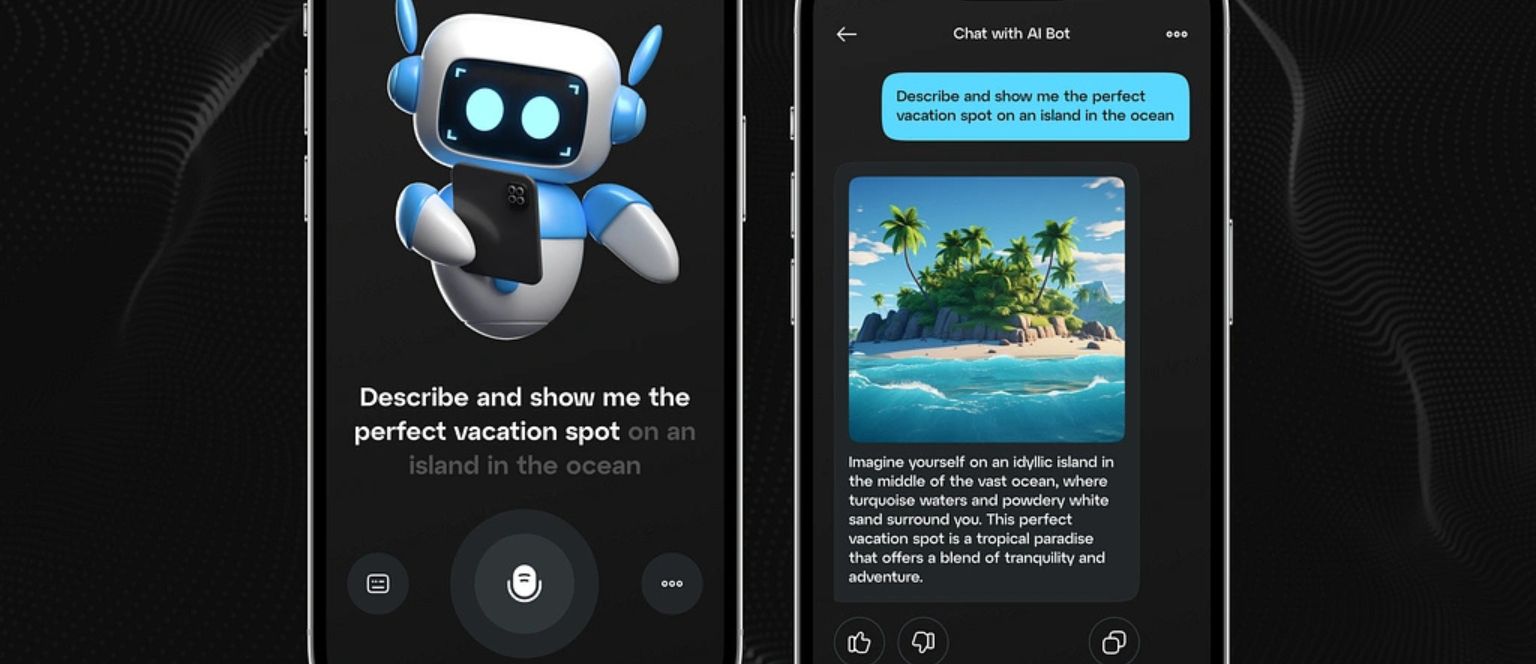Table of Contents
Developing a successful web application is a complex endeavor riddled with uncertainties. Entrepreneurs require thorough risk assessment and mitigation planning upfront to overcome challenges and deliver optimal returns. This post examines 9 common risks web app creators confront across technical, business and financial dimensions. It also provides established strategies to methodically address each risk via customer-centric, agile approaches. By comprehending potential hurdles and proactively applying the outlined best practices, founders can significantly improve their progressive web apps viability and commercial success odds.
As digital products become core to modern business operations, the technical risks involved in web application development require careful consideration and mitigation by development teams and web app development companies. Potential issues with reliability, performance and dependencies can severely impact the user experience and returns expected from such digital investments.
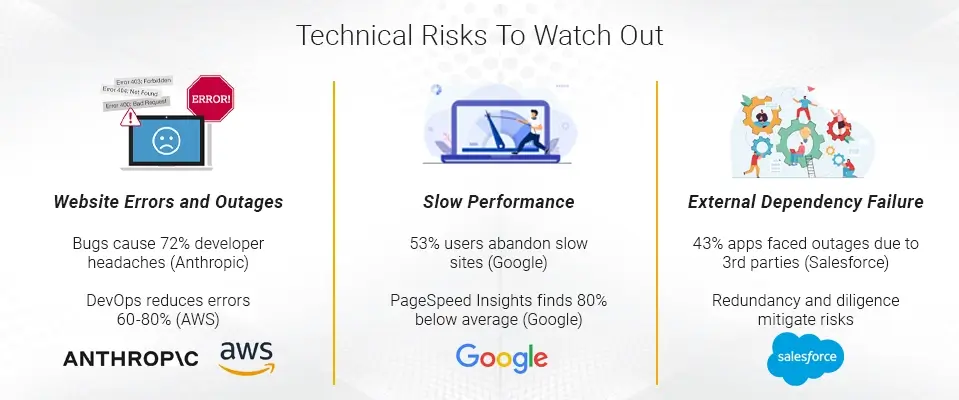
Technical Risks To Watch Out when Creating a Web App
1. Website Errors and Crashes
As per Anthropic’s 2021 Developer Survey, 72% developers face errors during testing. Adopting best practices like DevOps reduces errors by 60-80%.
During development and post-launch, unplanned errors or crashes will occur due to bugs, server issues, scalability problems, etc. A robust technology architecture with automated preventive checks and redundant systems minimizes downtime impact. Hiring experienced custom web app development companies proficient in core frameworks like .NET, Node.js or React helps identify bottlenecks and build stability. Extensive performance testing across browsers and devices exposed defects before public release. Progressive mobile web applications incorporating modern capabilities like offline support, and push notifications also aid resilience.
Also, one of the biggest pains for users and web app development services alike is a buggy website that crashes frequently. Nothing detracts from the perceived quality and credibility of a web app more than a poor reliability record. As front-end technologies continue advancing at a rapid pace, ensuring compatibility and error-free behavior across an evolving landscape of browsers, devices, and network scenarios becomes more challenging for web app development companies.
Rigorous testing practices must be institutionalized from design to deployment. Both manual validation of common usage flows as well as automated regression checks targeting rare edge cases must be conducted at regular intervals. This allows identification and remediation of issues before public release. DevOps methodologies for continuous integration and deployment further aid in catching bugs earlier. Qualified testers specialized in usability and compatibility evaluation also safeguard the seamlessness expected from modern web applications.
2. Slow Performance
According to Google, 53% of mobile users exit slow sites. PageSpeed Insights found 80% of apps scored below average speed. Using Lighthouse helps improve performance by 30-50%.
Sluggish loading speed and long response times frustrate users and raise high bounce rates, negatively impacting ROI. Factors like a heavy paperweight from images/scripts, server latency, or insufficient infrastructure capacity commonly affect performance. This risk is reduced through technology choices like optimized frontend code, asset compression, CDN delivery, and modern hosting infrastructure. Performance tuning must continue as user/traffic volumes grow. Reputable progressive web app development company experts apply proven techniques to ensure apps meet common performance benchmarks.
So, a slow website that annihilates user experience is a cardinal sin in today’s instant world. Yet performance issues commonly creep in during development due to unoptimized assets, code bottlenecks, inadequate caching, bloated payloads, or inefficient database queries. As websites increase in scale and complexity, custom web app development company experts must focus on performance as a core non-functional requirement.
Also, profiling and instrumentation help pinpoint slow components for optimization. Measures like image compression, code minification, lazy-loading, output caching, database indexing, and selective plugin usage can dramatically enhance speed. Load testing further ensures responsiveness remains unaffected under heavy simulated user loads. Overall, performance must be engineered as a cultural priority rather than an afterthought to guarantee fluency throughout the application lifecycle.
3. Dependency on Third-party Services
Poor user validation leads to wrong product-market fit. Lean Startup Methodology improves chances by 75%.
While using active third-party services, plugins, and SDKs expands capabilities, it also introduces dependencies that cross-platform mobile app development services must account for. Changes to external APIs, outages or partners potentially retiring tools can abruptly impact functionality.
Upfront due diligence of service level commitments aids risk assessments. Local fallbacks devoid of dependencies enhance resilience to third-party disruptions. Core data stored separately from external systems safeguards critical functionality. Overall, a judicious, modular approach to third-party integration architected for autonomy forms a risk-mitigated foundation for web app development.
So, relying on external services like payment gateways, maps APIs, and third-party authentication exposes apps to downtime risks if the vendors’ services fail or change terms. Though indispensable, such dependencies need fallback options. Critical app data must reside internally to circumvent external factors. Service level agreements provide protections but can’t guarantee 100% uptime. Diversifying point solutions mitigates overreliance on any single vendor.
4. Low User Adoption and Engagement
Idea validation saves 50-80% costs than rebuilding later. MVP traction metrics show 30% lead to first customers.
The biggest test is user acceptance. To minimize adoption risks, validate ideas with potential users through prototypes and MVPs before development. Get early feedback to ascertain true market fit and demand. Budget adequately for marketing and promotion during launch to drive initial user onboarding. Continuously enhance usability based on analytics and feedback to retain users over time. Track engagement metrics like time spent, repeat usage, and task completion.
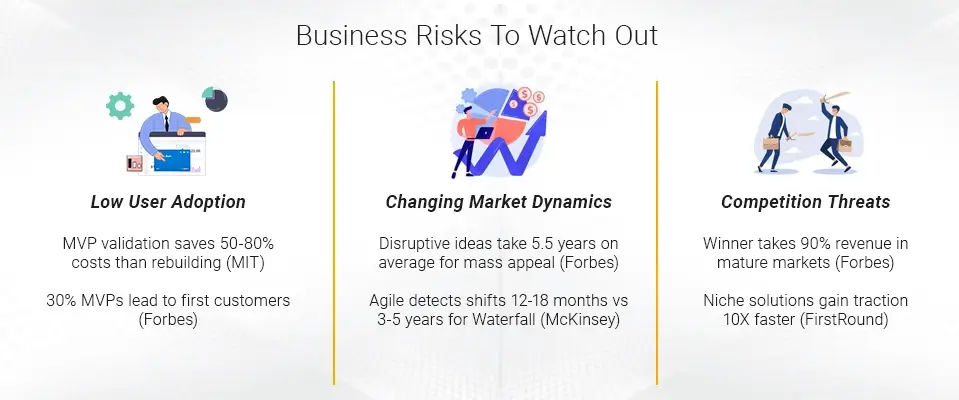
Also, failure to solve genuine problems could render the best technology redundant. Effective MVP validations and prototypes test ideas at early stages with target users. User interviews gauge true demand before investing heavily in development. Promotion budgets and constantly enhancing the UX based on analytics help drive user acquisition and retention crucial for sustainable ROI.
5. Changing Market Dynamics
Disruptive ideas take 5.5 years on average to gain mass appeal. Agile techniques detect changes in 12-18 months vs 3-5 years with Waterfall.
Markets evolve fast while web projects take time. Unpredictable changes in technology, user preferences or competition dynamics could undermine strategies. Stay updated on emerging trends and their potential impacts. Make core application features adaptable to changes with minimal rework. Diversify value propositions and use cases to de-risk dependence on any single market dimension. An agile, responsive approach future-proofs projects.
Technical projects typically span months but markets evolve rapidly. Shifts in technologies, consumer preferences, regulations, and competitor moves during productization could upend strategies overnight. An agile yet adaptive plan facilitates adjustments to changing realities. While the core offering aims to provide lasting utility, diversifying use cases improves resilience to external flux. Staying current on industry trends through communities and research helps foresee inflection points and recalibrate appropriately.
6. Competitor Threats
The winner gets a 90% revenue share in mature markets. Unique solutions catering to niche pain points gain traction 10X faster.
New entrants or substitutes could undermine the user base and revenues over time. Conduct competitive research to understand the strengths and weaknesses of alternatives. Clearly define the unique value proposition to carve a sustainable niche. Loyal brand communities and network effects provide resilience against competition threats.
Dependence on a consolidated target base exposes apps to competition risk. New entrants may serve similar needs better or attract customers through innovative business models. Building strong brand communities and exclusive features provides some insulation. Thoroughly evaluating the competitive landscape helps identify strengths to amplify as well as opportunities for differentiation. Continuous product refinement extends advantages against challengers. Partnerships can also diffuse competition by collaboratively serving larger markets.
7. High Development Costs
Scope review cuts 40-60% costs. Outsourcing non-core work saves 30-50%. Automated testing slashes costs by 20-30%.
Web app development involves significant research and planning for new technologies, algorithms, and integration with third-party services and databases. These projects require exploring various options and iterations to identify the most effective solution. While the innovation-driven approach unlocks new possibilities, it also inflates costs substantially if not managed well.
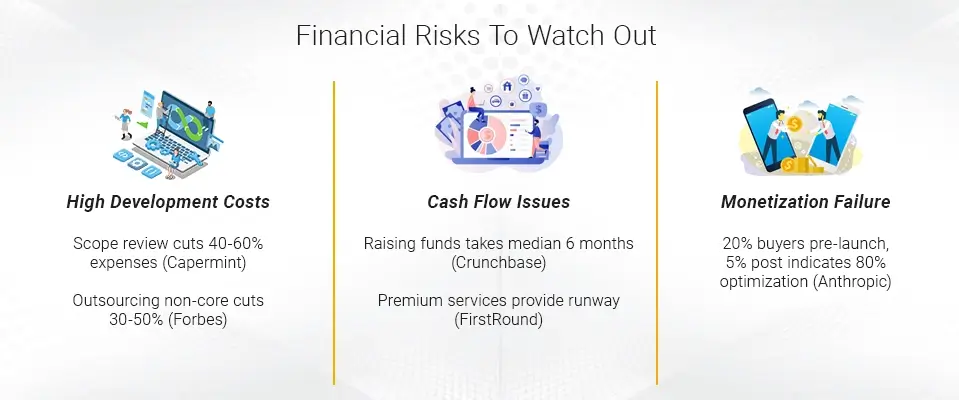
Engaging the right rather than free app builder is important to optimize investments. Leading web app development agency with proven experience in similar projects can provide accurate time and cost estimates based on a thorough assessment of requirements, scale of operations, dependencies, complexity factors, etc.
The modular development approach breaks large monoliths into independent, interconnected modules that can be developed and tested separately, in parallel. This improves resource utilization plus allows the outsourcing of non-critical components to specialist partners. For example, front-end development, UX design, backend API, database migration, etc can be undertaken simultaneously by independent dedicated teams to expedite schedules.
Experienced firms follow formal agile methodologies which structure development into short iterative cycles called sprints, keeping work-in-progress to a minimum. Rigorous unit and integration testing after every cycle catches issues early.
Features can be prioritized based on their perceived value, ease of implementation, and risk factors. Avoiding speculative additions prevents scope creep. Automating repetitive tests further enhances productivity. Gold-plating projects with features having uncertain or low demand impact costs adversely. Credible web app development companies advise optimally based on their understanding of similar projects and client industries.
Overall, it is important to hire the best PWA developers to provide fixed cost estimates, focusing only on critical features, outsourcing non-core work, and following disciplined agile processes can optimize investments and deliver the web app within affordable budgets without compromising on quality or functionality.
8. Cash Flow Issues
Raising funds takes a median of 6 months. Revenue from premium services provides a runway. Equity crowdfunding generates ₹50-100 crore yearly in India.
Financing web projects entirely through internal capital carries risks if estimation goes wrong or revenues are delayed. Most entrepreneurs don’t have reserves to continuously fund development, product support and promotional activities for many months. Alternative financing models deserve evaluation.
Crowdfunding platforms help generate early seed capital by enabling potential customers or supporters to invest in exchange for perks/rewards once the product is launched. Monetizing parts of the app during the development stage itself brings cash inflows. For example, premium services, subscriptions, consultancy around the core domain of expertise, etc.
Equity investment or convertible loans from angel investors or venture capitalists infuse non-dilutive capital to fund critical operations until positive cash flows. Showcasing a Minimum Viable Product (MVP), validation of the core idea and a realistic go-to-market plan attracts such backers. Availing grants from trade bodies or government organizations based on project innovation or local economic impact also eases pressure on internal reserves.
Collaborating with web app development companies that have experience with such financial models connects entrepreneurs to alternative funding channels and potential co-investors. Experienced agencies often take a measured stake in exchange for development services, incentivized to maximize ROI.
Overall, carefully estimating fund requirements post feasibility studies, pursuing complementary revenue streams, raising capital through multiple sources, and involving specialized partners help tide over the initial phase without running out of capital mid-way. Proper cash flow planning and a prudent spend-earn cycle are paramount to completing the project sustainably with an adequate growth runway.
9. Monetization Failure
Pre-launch surveys find 20% of buyers for paid apps. Post-launch, only 5% convert indicating monetization optimization potential.
Proving a compelling value proposition is not sufficient if customers remain non-paying. Effective monetization through diverse, phased models increases the chances of acquiring paying users post-launch.
The traditional Freemium model offers access to core features for free to maximize reach while charging for premium tiers or add-ons. Features enabled via freemium lure prospects to eventually upgrade provided they solve an acknowledged problem or convenience.
Upfront payments, subscription, or utility-based pricing charge either one-time or recurrently based on planned usage. Gift cards, and virtual currencies incorporated within gamified experiences boost engagement and facilitate micro-transactions. In-app purchases similarly encourage impulse spending.
Combining multiple payment types optimizes conversion paths for diverse buyers. Metrics like retention, conversion rates, and average revenue per user (ARPU) provide fact-based inputs to improve monetization tactics continuously. A custom web app development company well-versed with iterative testing can efficiently optimize monetization.
Surveys elucidate willingness to pay for proposed premium tiers whereas A/B tests validate their actual subscription or payment likelihood. Early access programs test pre-launch commitments, giving valuable user feedback and pre-sales.
Overall, extensive customer validation of revenue streams coupled with data-driven refinements optimize monetization models. Multiple concurrent approaches diversify revenue streams for commercial success even in volatile markets. Continuous testing and optimization guided by experts pave the way toward realizing projected ROI.
Strategies to Ensure ROI
Strategy #1: Validate via MVPs
The Minimum Viable Product or MVP approach is one of the most effective ways to minimize the risks of developing a product that does not resonate well with target users. Through MVPs, entrepreneurs can rapidly test core assumptions about a solution’s value proposition at an early stage before making major investments.
Custom app development services providers facilitate MVP creation utilizing tools like Bootstrap, CSS frameworks, and low-code platforms. Such lightweight prototypes allow engaging potential customers to qualitatively understand needs, pain points, and preferences. Their feedback helps identify the most important problems to focus on initially and helps iterate the concept faster.
So, MVPs should incorporate the basic workflow to gather quantitative metrics around engagement and retention. Features can subsequently be added in sprints based on learnings. This iterative approach ensures building only what users actively want, reducing wastage compared to conventional ‘big design upfront’ models.
Testing MVPs with subsets across different locations helps further validate the market potential. It also serves to establish early brand awareness and gauge mindshare ahead of the final launch. Credible top mobile app development companies in the USA encourage extensive MVP validation while targeting viable niches and scalable business models to enhance ROI certainty.
Strategy #2: Continuously Enhance UX
According to surveys, over 80% of users tend to abandon apps due to poor user experience, impacting retention, satisfaction, and long-term engagement. To maximize value from the user base and ensure app stickiness, UX must remain a constant area of improvement.
iOS app development companies emphasize using an analytics suite integrated into the development toolkit to gain deep insights into usage patterns, pinch points, feature preferences, etc. This data forms the core input for refining interfaces, flows, and functionality to solve pain points more intuitively over successive updates.
Also, testing out dynamic layouts or interactions through A/B prototypes validates enhancements empirically before rolling out. An easy-to-use, self-explanatory UX boosts organic adoption as positive reviews draw more installs. Alternatively, integrating AI/ML builds tailored experiences based on individual profiles.
Partnering with specialized mobile application development consulting services helps unearth untapped UX optimization opportunities. Their best practice recommendations combined with in-app analytics fuel continuous enhancement securing high engagement and customer delight critical to withstand competitive threats.
Strategy #3: Strengthen Value Proposition
Communicating the unique value delivered fosters stronger emotional connections among target users and builds a sustainable competitive differentiation and pricing power. This strategy relies on thoroughly understanding specific pain points or jobs through qualitative user research.
Android app development agency experts advise crafting personas around segmentation attributes like demography, profession, interests, pain points, etc. Case studies and surveys involve these personas to surface latent problems. The insight fuels an empathetic, problem-solving-oriented value proposition resonating powerfully with those customer groups.
So, customizable solutions catering to versatile needs and lifestyles through configurations and personalizations render the app indispensable. Strategic partnerships unlock complementary capabilities addressing customers’ entire workflow tightly. Exclusive rewards programs, knowledge hubs, and niche social networks bind communities compellingly. All these aspects strengthen stickiness against competition.
Overall, addressing authentic customer needs through qualitative discovery and innovative ways creates immense brand loyalty and positive word-of-mouth, the best defense against substitution threats to business continuity and profitability over the long term.
Strategy #4: Optimize Marketing Spend
Instead of spraying campaigns across all channels, zeroing in on high-intent audiences using contextual targeting maximizes returns on marketing dollars. Analysis of organic installs through analytics suites reveal preferred online and offline discovery routes.
Custom mobile app development company experts suggest optimizing exposure through these affinity communities and social graph networks. Tasteful retargeting reinforces value among receptive segments without annoyance. Also, qualified leads generated through account-based marketing get directed to LTV focused onboarding programs.
Influencers organically vouch the app within endemic forums. Calls-to-action seamlessly placed native to high-intent content inspire trusted trials. Frequency capping limits distraction without hindering discovery. Offline synergies like retail brand tie-ups multiply reach cost-effectively.
So, continuous A/B campaign assessment and prompt reinvestment of realized incremental value into newer channels sustains the positive flywheel. This data-backed approach concentrates budget towards the most responsive routes maximizing bang for every buck instead of diluted generalized promotions.
Strategy #5: Embrace an Agile Methodology
The unpredictable nature of markets necessitates flexible, iterative development approaches. Agile methodology addresses this through its ability to incorporate evolving needs seamlessly.
Under Agile, complex projects break down into timeboxed sprints, usually 2-4 weeks long. At the start of each sprint, cross-functional teams including custom app development services experts, plan and prioritize user stories. Frequent code deployments allow testing new features faster to gather timely user response.
Daily stand-ups foster transparency while Product Backlogs, Burn-down charts help maintain visibility and progress. Mid-sprint adjustments optimize outcomes through self-organization and collaboration versus command-control. Cross-functional integration reduces bottlenecks and defects improving productivity manifold.
Also, agile helps cope with changing guidelines smoothly using its organic, people-centric nature. Building only what delivers greatest value minimizes wasted efforts. Early deliverables allow validating assumptions to course-correct if required.
Top hybrid mobile app development companies in USA attest to Agile yielding 80% higher success rates than traditional methods for its emphasis on adaptability, communication and continuous improvement. So, its living documentation and built-in flexibility prove invaluable in dynamic market conditions.
Strategy #6: Engage Expert Resources
While enthusiastic founders pilot innovations, specialized skills safeguard quality and optimize probabilities of desired outcomes. Technical debt or unrealistic ambitions could otherwise cripple initiatives.
Leveraging expert iOS app development companies adds the missing pieces about design patterns, iterative developments, deployment best practices, go-to-market analysis through their war-chest of institutional learnings. Also, such developers own deep experience on frameworks, API integrations, 3rd party services facilitating faster integration hassle-free.
So, user experience design consultancy from dedicated android app development agency ensures customer-centricity via persona creation, task flows and usability reviews.
Proper UX foundations foster higher conversions and retention. Performance engineers guarantee responsiveness across platforms.
Quality assurance experts catch defects proactively via automation. Marketing agencies provide launch readiness through branding, target audience acquisition blueprints minimizing post-launch uncertainties. Overall, specialist partnering de-risks the initiative through their tried-and-tested methodologies.
Strategy #7: Multiple Revenue Streams
Relying entirely on a single monetization model leaves businesses vulnerable to external dynamics beyond control. A diversified income portfolio balances this risk.
Also, adopting an enterprise mobile app development company recommended a “parallel diversification” approach helps launch complementary monetization experiments in tandem. Examples include bespoke services around a core tech, multiple pricing tiers, in-app purchases of virtual items, and affiliate commissions on products sold within the app ecosystem.
Subscription revenue offers predictable cash flows when bundled with tangible value-adds. One-time service fees extract value from infrequent transactions. So, advertisements placed contextually generate stable additional income. Partnerships bring in shared profits from collaborative ventures.
Also, properly assessing profitability drivers and constantly iterating the right combination through A/B testing hedges against any one model’s instability for assured long-term financial sustainability of the business proposition.
Final Thoughts
A holistic outlook weighing technological, operational, and commercial elements supported by rigorously validated learning delivers the surest path to a web app’s productive longevity. Also, thorough comprehension and mitigation of risks coupled with customer-centric problem-solving equip founders with resilience against surprises while unlocking new opportunities. Overall, a risk-aware yet progressive mindset guided by data and specialist inputs safeguard investments and facilitates realizing the envisioned value. So, if you are looking for more assistance, then you can hire a web app developer at A3Logics and get all the assistance you need. The experts are going to help you with all the information and services.
FAQs
Q1. How can MVP help reduce risks?
Ans. MVPs obtained qualitative and quantitative feedback from target users to iterate the app concept and identify the core value proposition before development, preventing wasted efforts on wrong assumptions.
Q2. What are some common technical risks?
Ans. Website errors and crashes caused by bugs, a slow performance due to heavy assets or inefficient code, dependency on third-party services vulnerable to external outages, etc are major technical risks.
Q3. How to reduce marketing budget risks?
Ans. Targeted campaigns through referral sites, influencers, and niche communities optimized resource allocation against mass promotions benefitting specific intent audiences concentrating outreach.
Q4. How do Agile and UX enhancement help?
Ans. Agile methodologies facilitated frequent iterations adapting to dynamic markets. So, data-driven UX improvements constantly refined interfaces boosting user engagement crucial to sustained operations.
Q5. What are strategies to guarantee ROI?
Ans. Validating concepts via MVP, continuously optimizing UX, strengthening differentiated value propositions centered around customer needs, prudent marketing spending and engagement of specialists to help deliver returns on web app investments.



